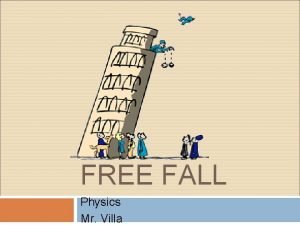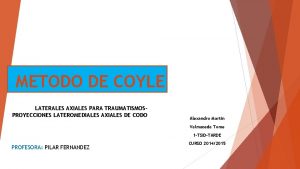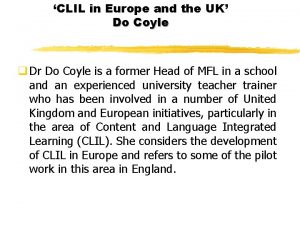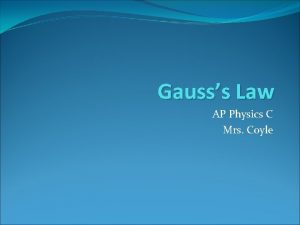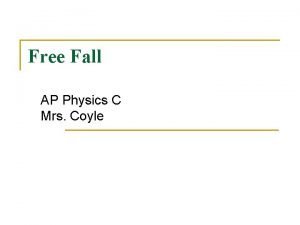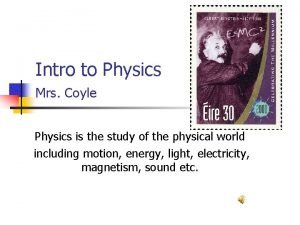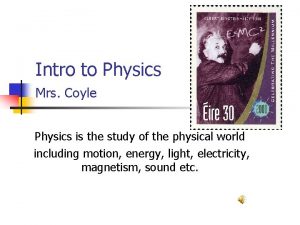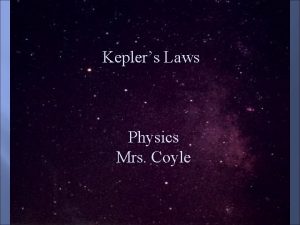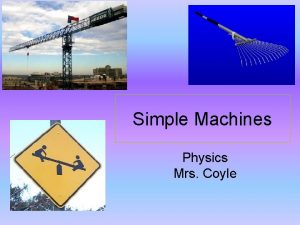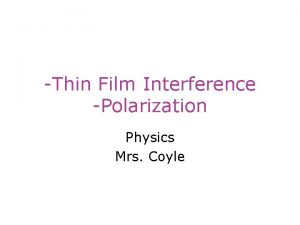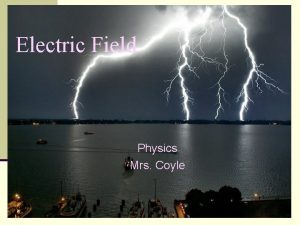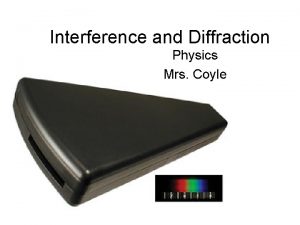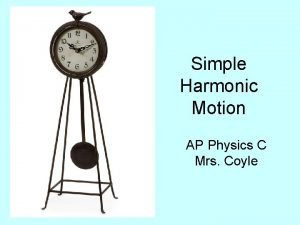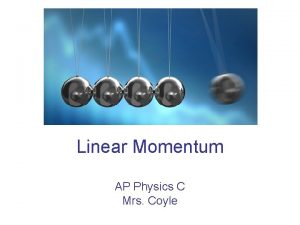Free Fall Physics Mrs Coyle Stuntmans Free Fall



















- Slides: 19

Free Fall Physics Mrs. Coyle Stuntman’s Free Fall – Great Adventure 2004

Questions: n n Do heavier objects fall faster than lighter ones when starting from the same position? Does air resistance matter? If the free fall motion has a constant acceleration, what is this acceleration and how was it found? How do we solve problems involving free fall?

Apollo 15 -Astronaut David Scott on the Moon (1971) n n Hammer and Feather on the Moon http: //www. archive. org/details/NIX-LV-199800046

Galileo (1564 – 1642) and the leaning tower of Pisa.

Does Air Resistance Matter?

Air Resistance n The force of friction or drag acting on an object in a direction opposing its motion as it moves through air.

Hammer & Feather in the presence of air

Hammer & Feather in the absence of air

n If the free fall motion has a constant acceleration, what is this acceleration and how was it found?

Galileo’s Ball and Channel Experiment http: //www. ifa. hawaii. edu/~barnes/ast 110_06/rots/pftim 19_01. png

Galileo’s Ball and Channel Experiment n n n He varied the starting position of the ball along the channel. He measured the times for the ball to travel the various lengths. He raised the channel until it was steep enough to simulate free fall.

Galileo’s Finding n “ We compared the time for the whole length with that for the half, or with that for two-thirds, or three-fourths, or indeed for any fraction; in such experiments, repeated a full hundred times, we always found that the spaces traversed were to each other as the squares of the times, and this was true for all inclinations of the plane, i. e. , of the channel, along which we rolled the ball. Galileo “Two New Sciences” n http: //galileoandeinstein. physics. virginia. edu/lect ures/gal_accn 96. htm

How Far? Distance (m) 0 Time (s) 0 5 1 20 2 45 3

To Find Distance from t and g: d=vit + ½ g t 2

How Fast?

Acceleration due to Gravity, g n g=-9. 8 m/s 2 (we often use -10 m/s 2) g= v f –v t n n i When vi=0: vf=gt Note: the down direction is usually assumed negative.

vf= vi+ gt vavg = ½ (vf +vi) Equations of Motion for Uniform Accelerated Motion d= ½ (vf + vi)t d= vit + ½ gt 2 vf 2 = vi 2 + 2 gd n n d is the displacement (or Δd) Assume that ti=0

Example 1: Free Fall a) b) c) A ball is dropped from rest from the top of a building. Find: The instantaneous velocity of the ball after 6 sec. How the ball fell. The average velocity up to that point. Answers: -60 m/s, 180 m, -30 m/s

Example 2: Free Fall on the Moon A hammer is dropped on the moon. It reaches the ground 1 s later. If the distance it fell was 0. 83 m: 1. 2. Calculate the acceleration due to gravity on the surface of the moon. Calculate the velocity with which the hammer reached the ground and compare to the velocity it would have, if it was dropped on the earth’s surface. Answer: -1. 66 m/s 2, -1. 66 m/s, -9. 8 m/s
 Physics of free fall
Physics of free fall They are mrs garcia and mrs castro
They are mrs garcia and mrs castro They are mrs garcia and mrs castro
They are mrs garcia and mrs castro Mrs. darling was ___________ of mrs. s.
Mrs. darling was ___________ of mrs. s. Metodo del codo
Metodo del codo Coyle method
Coyle method Coyle method
Coyle method Caitlin coyle
Caitlin coyle Do coyle clil
Do coyle clil Isabelle degrange
Isabelle degrange Coyle
Coyle Coyle health and wellbeing
Coyle health and wellbeing Coyle electric
Coyle electric Aaron coyle
Aaron coyle Goethe mindmap
Goethe mindmap Dr christine coyle
Dr christine coyle Why does it happen
Why does it happen University physics with modern physics fifteenth edition
University physics with modern physics fifteenth edition Ib physics ia examples
Ib physics ia examples Physics fall final exam review
Physics fall final exam review
